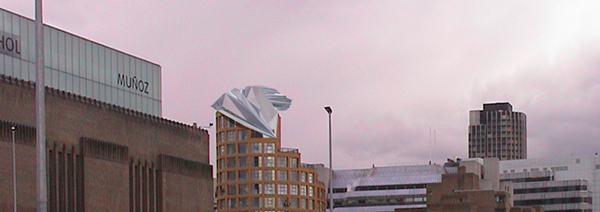
Creative Process: .::[Intuition] .::[Form] .::[Design] .::[Principle] .::index>>

Intuition
The project was instigated as an intuition that parametric modelling (relational
geometry) will allow for complex yet efficient 3-d space/form assemblies.
As such it may be thought of as an attempt to model the latency of parametric
systems prior to their technical assimilation. It has evolved as an attempt
to articulate this elegantly in formal and technical terms as a dramatic yet
principled form that is striking in the urban context.
Form
We liken the genesis of the project to calligraphy in that a period of assimilation
of the complex brief led to a highly articulate ‘gesture’ that
negotiates the complex formal and techical constraints:
- an awkward stepped spiralling towertop site
- a client request for views in all directions
- the ability to nuance thermal performance (in respect of stringent Building
Regulations)
- a need to modulate its structural form (to respond to an unknown structural
capacity)
- the need for a lightweight prefabricated construction logic (to avoid nuisance
to the occupants)
Design
The resulting form, a series of spiralling 3d structure/surface elements,
offers a dramatic completion to the tower, whilst offering a radical interior
spatiality. The implicit assumption is that its form can be articulated as
a series of variable parameters (not determined at the outset, but intuited),
such that its non-standard character is ‘managed’ as a series
of topological variants (ie the elements obey the same rules but are non-standard
in their expression).
What is also implicit is that the emergent surface/form needs
to be highly performative – structure, insulation and weatherproofing
‘trapped’ within its thickness - an essential recovery of efficiency
within a now complex formal environment (CAD/CAM). ie there is a collapse-back
of distinction in regards to functional performance: structure and surface,
for instance, or insulation and waterproofing merging into composite structure/surface
assemblage (specifically resin-filled aluminium honeycomb).
There is also a need for highly accurate and articulate fabrication
techniques, which implies 5-axis numeric command machining, the structural
box-trusses then assembled from bevelled triangular panels.
Principle
Within a digital environment, where variancy is the norm, open-ended and proliferating
generative strategies are employed, sampling and editing displacing design
determinism as the essential aptitude of the architect. Parametric modelling,
which models variables within a dynamic system, demands that the architect
articulate the essential parameters and their implication within a generative
environment: how does one establish the rules by which an architecture might
be produced rather than a singular determination of form? The paramorph emerges
as the principled opponent to accidental methodologies of form-generation.